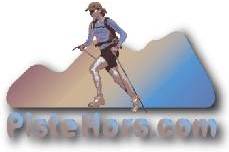Hiking
Getting Your Bearings
Most of the routes in our hiking section stick to the beaten track, even if some of the tracks are less beaten than others. A detailed map on a scale of 1:25,000 is essential for both planning and route finding. Main walking paths are well marked in France but may of the more interesting routes on PisteHors.com are poorly marked and the tracks are not even shown on IGN maps. You are relying on out route description and locating features described on the ground; a map, compass and altimeter are the essential tools for orientation, especially if the weather closes in. The thing is, you don't want to be fumbling with your map and compass for the first time in low cloud. You need to train and possibly the best way to do this is on an orienteering circuit.

Navigating with map and compass
Many mountain resorts have laid out permanent circuits (courses d'orientation). For a couple of euros you can buy a map from the tourist office which shows the location of control points. Now orienteering may conjure up images of bearded guys with satin shorts prancing around the local woods but it is an ideal activity to work on navigation skills on poor weather days and some of the areas are usable in winter as well as summer. We tried out one circuit in the 1968 Olympic ski resort of Chamrousse in the Belledonne mountains. Chamrousse has around 40 control points with 6 course suggestions. One of the routes can even be completed on mountain bike. The Chamrousse control points are traditional affairs. They consist of a wooden post marked with a red triangle and holding a control punch. The punch leaves a defined pattern in a card. This is useful for competitions to show that the course has been completed.
The best bet is to start with the beginner circuit. At Chamrousse this is laid out in the plateau d'Arselle area. In the winter this is a busy nordic ski area but at the start of October it was just us and the mushrooms that were sprouting everywhere. Because we were doing the course with an easily tired three year old boy we decided to complete a smaller loop than the one suggested, leaving out a small climb to the Bachat Bouloud development.

Control Point
The key to navigating is knowing where you are starting from and the point of orienteering is to navigate between control points by the shortest practicable route. We went to the south-west corner of the ESF building. From here we aligned the edge of the compass along the route we wanted to control point 51. We then rotated the compass dial to align orienting lines with map north. Normally we would apply a correction between map north and magnetic north but in the south east of France this is practically 0 so all that remained was aligning our compass needle with the orienting arrow and following the indicated direction. An additional aid, especially in poor visibility, is to count paces. The Arselle map is 1:7500. That is 1cm on the map represents 7500 cm on the ground (or 75m). The edge of the compass has a convenient ruler, so we knew we had to cover about 250 meters or about 500 paces.

Line up compass with the objective
We set out for our first control. The description said it was by a lone pine. In fact there were two lone pines in the general area we were heading. Mum followed the compass bearing while I was convinced it must have been the pine to the left. In fact Mum passed very close to the other pine and spotted our first control. Navigating to the second control involved crossing some deep woodland. Junior was not happy with this so we did it as two legs. Navigating directly to a crossroads shown on the map then onto the control. This multistage technique is useful if there is a lot of ground between controls where a small error in the bearing could result in a big error on the ground or where there are obstacles such as cliffs or lakes as was the case between points 66 and 67 which are separated by marshy ground.

Turn orienteering lines to grid
Another useful technique is sighting off, that is deliberated plotting a course to the right or left of the point you are looking for. This helps allow for navigational errors so that you are sure of arriving to a known side of the control, you then turn in the direction of the control until you find it. Obviously this technique requires the control point to lie on an obvious feature such as a path, wall or river.

Orientate need to north
Everyone agreed that it was a fun and useful day. We discovered bits of the area we hadn't visited and learned skills that would be useful elsewhere. We are planning on going back to Chamrousse before the winter to cover the high mountain course around the lacs Achard and Roberts (Junior will stay home). The Chamrousse course is serious stuff, it was recently used as the orientation component of a European Mountain Leader award examination.
Recent Updates
- Main.Routes . . . October 09, 2010, at 09:30 PM by davidof?:
- Vercors.Vercors . . . September 09, 2010, at 07:42 PM by andybryant?:
- Belledonne.Belledonne . . . September 09, 2010, at 07:41 PM by andybryant?:
- Chartreuse.Chartreuse . . . September 09, 2010, at 07:41 PM by andybryant?:
- Vercors.Moucherotte-Vallon-Des-Forges . . . July 11, 2009, at 02:40 PM by fredos1?:
Page last modified on October 07, 2007, at 03:15 PM
